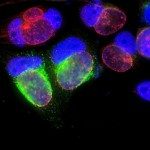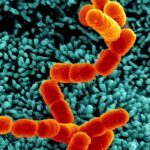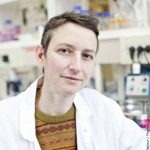Lien vers Pubmed [PMID] – 26981769
Elife 2016 Mar;5:e12552
For intracellular pathogens, residence in a vacuole provides a shelter against cytosolic host defense to the cost of limited access to nutrients. The human pathogen Chlamydia trachomatis grows in a glycogen-rich vacuole. How this large polymer accumulates there is unknown. We reveal that host glycogen stores shift to the vacuole through two pathways: bulk uptake from the cytoplasmic pool, and de novo synthesis. We provide evidence that bacterial glycogen metabolism enzymes are secreted into the vacuole lumen through type 3 secretion. Our data bring strong support to the following scenario: bacteria co-opt the host transporter SLC35D2 to import UDP-glucose into the vacuole, where it serves as substrate for de novo glycogen synthesis, through a remarkable adaptation of the bacterial glycogen synthase. Based on these findings we propose that parasitophorous vacuoles not only offer protection but also provide a microorganism-controlled metabolically active compartment essential for redirecting host resources to the pathogens.




